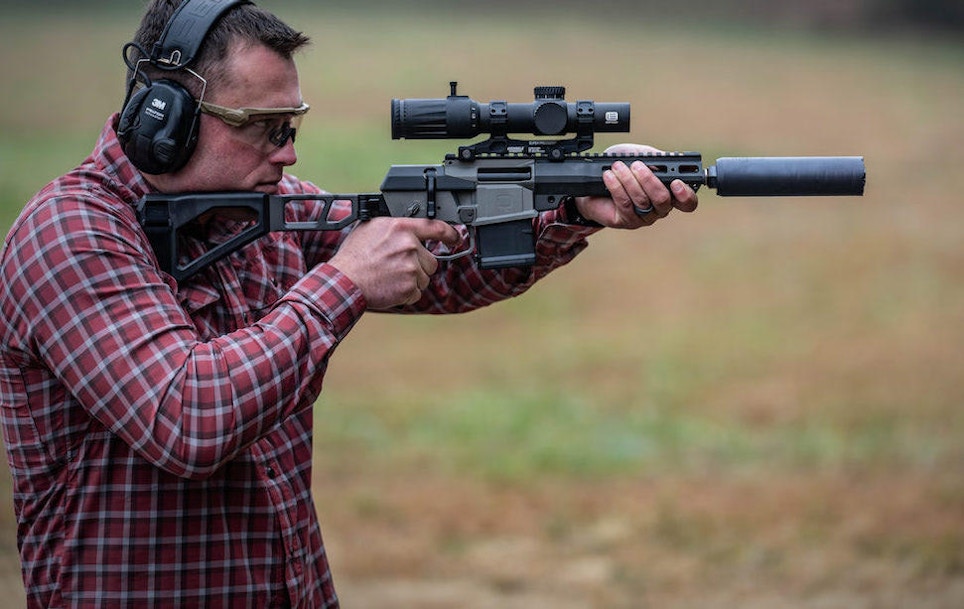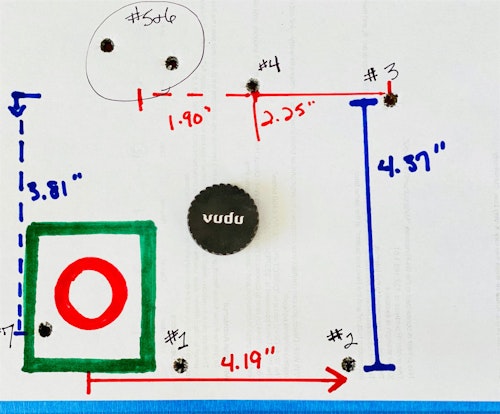Best known for its rugged and tactical holographic weapon sights, EOTech doesn’t receive similar recognition for its VUDU line of rifle scopes. And that’s very unfortunate, both for independent FFL retailers and their customers, who are missing out on some of the best scope options found in today’s optics market.
In the Spring of 2016, EOTech launched the first three VUDU models, all first focal plane optics, in 1-6x, 2.5-10x, and 3.5-18x magnifications. Since then, the Ann Arbor, Michigan-based EOTech added three scopes to the VUDU first focal plane line and introduced a VUDU second focal plane line with three models, while discontinuing just one VUDU scope, the 2.5-10x first focal plane model.
The VUDU line up is characterized by rugged and shock resistant aircraft-grade aluminum tubes, and extremely clear, anti-reflective glass that delivers sharp-edged images even in low light situations. The scopes are offered in numerous reticle options, in both MIL-RAD and MOA adjustments, and can be had with or without illuminated reticles.
The newest optic in this line is the VUDU 1-10x28mm first focal plane scope which offers impressive magnification, precise adjustments, and first-rate clarity in a more compact optic. And the VUDU 1-10x has a wider range of potential customers than many scopes as it clearly has serious applications for hunting, tactical, and law enforcement end users.
I received a VUDU 1-10x28mm scope for evaluation, the S4 model that used an MOA-based reticle with sub-tension marks for ranging, holdover and windage corrections at higher powers. The scope featured .25 MOA adjustment for elevation and windage, and a speed ring surrounding the center red aiming dot for rapid shots at lower magnification settings.
My VUDU model featured an illuminated reticle, with a push-button reticle illumination system located on the left side of the tube. The illumination system was easy to use, with a single button for ON/OFF, and two other buttons to add or subtract from the reticle’s brightness. Illumination was powered by a single CR2032 battery.
The VUDU’s elevation turret offers a simple push-pull locking system and the windage turret is capped, and both features prevent inadvertent control changes.
I considered the VUDU with the MOA reticle more of a hunting scope, but it should be noted that the VUDU 1-10 is also available in the SR-5 configuration, featuring an MRAD graduated Christmas-tree style reticle for more precise windage and elevation holds. For the Law Enforcement market, there is also the VUDU 1-10 LE-5 model, with a reticle similar to the SR-5 but instead of a single dot inside the speed ring it features a simple crosshair.
Around the Box
After loading the CR2032 battery into my evaluation VUDU 1-10, I mounted the scope onto a new CVA Cascade rifle chambered in 6.5 Creedmoor, using a pair of sturdy 34mm scope rings to attach the scope to the Cascade’s two, Weaver/Picatinny-style bases already affixed to the receiver top.
CVA’s first-ever bolt-action rifle, the Cascade is a hunting rifle designed for use in tighter spots like tree stands and hunting blinds, which explains the rifle’s shorter, 18-inch barrel. The Cascade featured a flush fit, detachable magazine, a synthetic, fiberglass reinforced stock and, at just 39-inhces long, weighed in a under 7 pounds
Following CVA’s barrel break-in directions, I first zeroed the VUDU at 50 yards. Here, the MOA adjustments were very precise. My initial shots placed a good foot low and 6 inches to the left. I counted off the about half the needed elevation clicks and fired, and the corresponding shot moved up the expected number of inches. I made the needed elevation and windage adjustments, fired and was soon on target, and then placing a couple three-shot hunting accuracy groups at approximately .50-inches, with the VUDU set at 6x magnification.
I moved to my outdoor range’s 100-yard lanes and proceeded to zero and then re-zero the Cascade and VUDU as I went through several different brands of 6.5 Creedmoor ammunition (I was also testing out the Cascade for review in a future issue of SSR). As expected, the points of impact changed a little to a fair amount per brand, requiring me to adjust the VUDU’s controls, which responded nicely.
It was time to “shoot the box” at 100 yards, the standard evaluation of a scope’s controls and the precision (or lack) therein. Generally, this process involves the first shot in the bullseye, then alternating between moving the elevation and windage controls several inches up/down and left/right, aiming at the bullseye, firing, and determining where the bullet tracks.
In theory, for example, the first shot drills the bullseye; the shooter then spins the elevation control the equivalent of 5 inches up and the next shot, also aimed at the bullseye, impacts approximately 5 inches up from the first shot.
For this test, I used Federal Premium’s 6.5 Creedmoor Medium Game round firing a 130-grain Barnes TSX all-copper bullet. First, I re-zeroed the VUDU for this particular round on a separate target, and then began firing the “Box” sequence.
But one of the potential problems of shooting said box is of course … the shooter. If a shot doesn’t land where it is supposed to, is it the optic or the person behind the rifle?
My first shot, for example, was aimed at the bottom of the red bullseye I’d drawn on my white paper target. But the shot hit about an inch to the right of where I’d hoped it would.
For Shot #2, I first clicked the Windage control 16 times to the Right, which at .25 MOA per click should have moved the next shot to the right 4 inches. I aimed for my red bullseye and squeezed off my shot. This struck the target at 4.19 inches to the right of the bullseye. Next, I clicked the Elevation control UP 16 times, for what should have been a 4-inch rise in shot #3’s impact.
That shot hit up 4.37 inches from my second shot.
Shot #4 adjustments had me heading back Left, but here I only clicked 8 times for 2inches. Point of impact was Left 2.25 inches. Another eight clicks left and here I pulled the next two shots, which did move over but where a little high. To measure the left shift of these two shots, I took the average distance of these two impacts from shot #4 and that came to 1.90-inches.
For my final shot, I clicked the elevation control down 16 times for 4 inches, which should have put me back to my original shot #1 point of impact. For this shot, though, I aimed intentionally to the left of my red bullseye so I could clearly see where it would strike the target. And it hit where I aimed, dropping down 3.81 inches. Pretty damned impressive. Factor in the shooter, the occasional gusting left-to-right breezes that day, and the target sitting 100 yards distant, and the .20-inch distance variations I recorded told me the VUDU was dead on, the controls extremely precise and very repeatable.
Flexibility Sells
So, the VUDU is in your display cabinet, and you know it’s a hell of a scope, but you have to know how to sell it.
Start with making sure your sales staff understands that the VUDU 1-10 is a very “flexible” optic that checks the boxes for many different customers and many different shooting scenarios, according to John Bailey, EOTech’s vice president of marketing and product management.
“The beauty of the 1-10x Vudu scope is that it fits in nearly every application,” Bailey notes. “It's first focal plane design and intricate reticle designs works well for the tactical user that may experience unknown distances and needs help for wind holds.
“For the hunter, the magnification range is ideal for most hunting applications. The VUDU offers a true 1X magnification for close range game but not too much magnification where the hunter loses the animal in the scope when dialing to greater magnification. And its locking elevation turret, etched and illuminated reticle, and one-piece eye piece are great features for any shooting discipline.”
And don’t forget to mention the VUDU’s throw lever. Let potential customers give that lever a twirl to experience how quickly it aids in increasing or decreasing the magnification.
Another feature to help to sell this and other VUDU scopes is the EOTech “NoBS” Limited Lifetime Warranty. As the EOTech website explains:
“Should your Vudu Riflescope ever experience any issues, we will repair or replace it, as determined by EOTECH, with a comparable product in equal or better condition, free of charge, PERIOD. You don’t have to be the original owner and you will not need to provide proof of purchase.”
As with most such warranties, theft, loss, neglect or vandalism are not covered, nor is damage covered which was caused by abuse, misuse, improper installation and modification, alterations, abnormal use, or accidents. For a complete explanation of the NoBS warranty and its exclusions, visit the EOTech website at www.eotechinc.com/help-center/warranty-information.
Concerning in-store help, Bailey noted that EOTech offers its qualified dealers a dealer kit that includes catalogs, swag and signage, plus a pop-up floor display. EOTech dealers also have access to all the company’s videos, which includes instructional and tutorial videos specific to the Vudu product line.
“EOTech has both direct sales managers as well as a large network of outside sales representatives that manage the day-to-day coverage for our dealer network,” Bailey said. “They visit the stores and provide training, sales opportunities, and inventory support.”
EOTech does offer a co-op advertising program, too.
“One of EOTECH's biggest strengths is its distribution channel,” Bailey says. “We sell to every outlet to include traditional wholesalers, independent dealers, LE specific dealers, and buy-groups who sell into its own independent dealer network. This is true internationally, as well. Our extensive distribution channel gives us the greatest reach and allows dealers the ability to go direct or work through wholesale distribution.”
And last, EOTech does on occasion offer Sales Performance Incentive Programs to incentivize the store staff.
“In addition, we provide training on ExpertVoice, https://www.expertvoice.com, a website for the firearms industry that provides training but also provides discounts on our products to the store staff,” Bailey notes.








